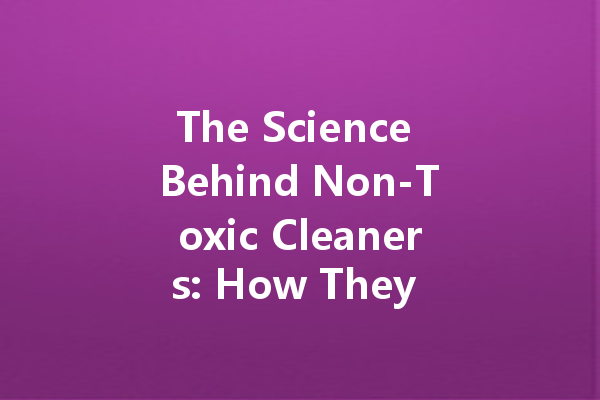Introduction
In recent years, there’s been a significant shift towards using non-toxic cleaners in households and commercial settings. This trend isn’t just a fad; it reflects a growing awareness of the harmful effects that traditional cleaning products can have on our health and the environment. In this article, we’ll explore the science behind non-toxic cleaners, how they function, and why they are a better choice for a healthy living space.
Understanding Non-Toxic Cleaners
What Are Non-Toxic Cleaners?
Non-toxic cleaners are products designed to clean surfaces without the use of harmful chemicals. Unlike traditional cleaning agents that may contain a cocktail of synthetic substances, non-toxic cleaners are often made from natural ingredients that are effective at removing dirt, stains, and germs without posing a risk to human health or the environment.
Benefits of Non-Toxic Cleaning Products
The switch to non-toxic products offers numerous benefits. Firstly, they are safer for children and pets who may come into contact with cleaned surfaces. Secondly, they reduce the risk of allergic reactions or respiratory issues that can be caused by volatile organic compounds (VOCs) commonly found in conventional cleaners. Lastly, many non-toxic cleaners are biodegradable, minimizing their impact on the environment.
The Science Behind Non-Toxic Cleaning Agents
Natural Ingredients at Work
Non-toxic cleaners utilize a variety of natural ingredients that have cleaning properties. Some common components include:
How Non-Toxic Cleaners Function
Non-toxic cleaners typically use methods such as emulsification, enzymatic action, or saponification to clean surfaces:

The Impact on Health and Environment
Reducing Exposure to Harmful Chemicals
Using non-toxic cleaners drastically reduces exposure to harmful chemicals that can linger in the air long after cleaning has occurred. Many traditional cleaners contain compounds linked to allergies, asthma, and other respiratory problems. By opting for non-toxic solutions, you’re making a healthier choice for your home and wellbeing.
Eco-Friendly Options Matter
Non-toxic cleaners play a crucial role in reducing environmental pollution. Many conventional cleaning products end up in our waterways, contributing to chemical pollution that harms aquatic life. Non-toxic cleaners, often made from biodegradable ingredients, break down naturally, posing less of a risk to wildlife and ecosystems.
Making the Switch to Non-Toxic Cleaners
Easy Transition for Homeowners
Making the transition to non-toxic cleaners doesn’t have to be complicated. Homeowners can start by replacing their current products with non-toxic options available in stores or even creating homemade cleaners using simple ingredients like vinegar, baking soda, and essential oils.
Cost-Effective Alternatives
Many non-toxic cleaning solutions are not only healthier but also cost-effective. Simple ingredients like vinegar and baking soda are inexpensive and can replace multiple specialized cleaners, leading to fewer purchases and reduced waste.
Conclusion
The science behind non-toxic cleaners reveals that they are a viable alternative to traditional cleaning products. Utilizing natural ingredients, these cleaners effectively maintain cleanliness without compromising health or environmental safety. As awareness of the risks posed by harmful chemicals increases, the shift toward non-toxic cleaning options will likely continue, making our homes healthier places to live. Embracing these products is a step toward a cleaner home and a healthier planet.
